After the success of the X-T2, Fujifilm announced the Fuji X-T3 successor on September 6, 2018. Sporting the fourth-generation 26.1 MP X-Trans CMOS 4 BSI sensor, X-Processor 4 processor, a fast 425-point hybrid autofocus system, and very impressive video recording features, the X-T3 was an instant success among Fuji enthusiasts and professionals. I had a chance to test the Fuji X-T3 back in 2018, but have not been able to post my detailed assessment of this phenomenal camera until today.
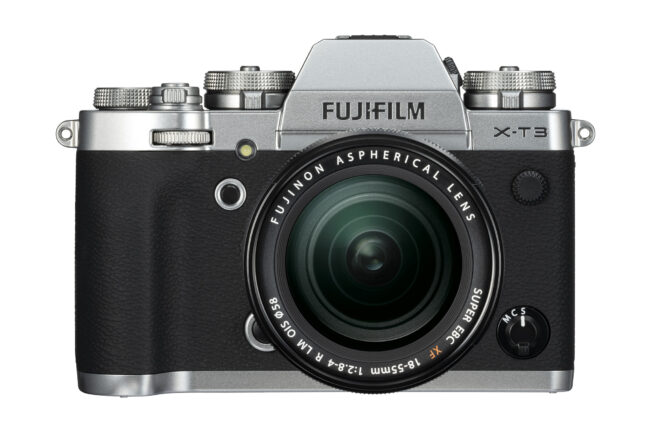
Since the debut of the Fujifilm X-T1, I have been a huge fan of the X-T series cameras. Although the Fuji X-T2 was a very appealing camera when it was released, I decided to skip a generation and wait for the X-T3. However, right before the announcement of the camera, Fuji pushed the mini-GFX X-H1 to the market and that’s the camera I ultimately fell in love with and purchased for myself. To date, the Fuji X-H1 has been my go-to camera for everyday and travel needs, and I absolutely love its ergonomics, as well as its best-in-class in-body image stabilization (IBIS). You can read my in-depth review of the Fuji X-H1, where I share my thoughts on that camera.

When the X-T3 was finally revealed, I looked at its specifications and compared them to the X-H1. While the X-T3 certainly had the latest-generation sensor and image processor, it lacked IBIS, which I found to be invaluable for my needs. This was especially noticeable when I tested out the X-T3 while traveling in the US, Jordan and Turkey, as I had to resort to using a tripod more often than I would like. After getting spoiled by the amazing IBIS on the X-H1, it was quite difficult to use a camera without it. In addition, the X-T3 felt like a compromise to me in terms of ergonomics – I missed the large grip and the useful OLED top screen from the X-H1. With the release of the latest X-T4, Fuji has finally added IBIS and changed to a larger capacity battery – the two biggest complaints I have with the X-T3, as I detail in this review.

Let’s take a look at the X-T3 in more detail.
Fujifilm X-T3 Specifications
- Sensor Resolution: 26.1 MP, 3.75µ pixel size
- Sensor Type: BSI CMOS (X-Trans)
- Sensor Size: 23.5 x 15.6mm
- Image Size: 6240 x 4160
- Image Processor: X-Processor 4
- Native ISO Sensitivity Range: 160-12,800
- Boost ISO Sensitivity: 80, 100, 125, 25600, 51200
- Sensor Cleaning System: Yes
- Lens Mount: FUJIFILM X mount
- Weather Sealing/Protection: Yes
- Body Build: Magnesium Alloy
- Shutter: 30sec – 1/8000 mechanical shutter, up to 1/32000 electronic shutter
- Storage: 2x SD slot (SD/SDHC/SDXC, UHS-II compatible)
- Viewfinder Type: 3.69m-dot OLED color viewfinder
- Viewfinder Coverage and Magnification: 100%, 0.75x
- Autofocus System: 425-point hybrid AF system
- Continuous Shooting: 11 FPS, up to 30 FPS with electronic shutter and 1.25x crop
- Exposure Meter: TTL 256-zones metering
- Built-in Flash: No
- LCD Screen: 3.0″, 1.04m-dot Tilting Touchscreen LCD
- Video Maximum Resolution: 4K and DCI 4K @ up to 60p
- HDMI Output: 4:2:2, 10-bit
- GPS: No
- Wi-Fi / Bluetooth: Yes / Yes
- Battery Life (CIPA): 390 shots
- Weight: 489g (excl battery and memory card)
- Dimensions: 133 x 93 x 59mm
- Price: $1499 MSRP (body only)

A detailed list of camera specifications is available at Fujifilm.com.
Camera Construction, Handling and Controls
Similar to its predecessors, the Fuji X-T3 also features a high-quality full magnesium-alloy construction from front to back, so it is designed to be (ab)used in the field – it is a true workhorse camera. Just take a look at its magnesium alloy shell:
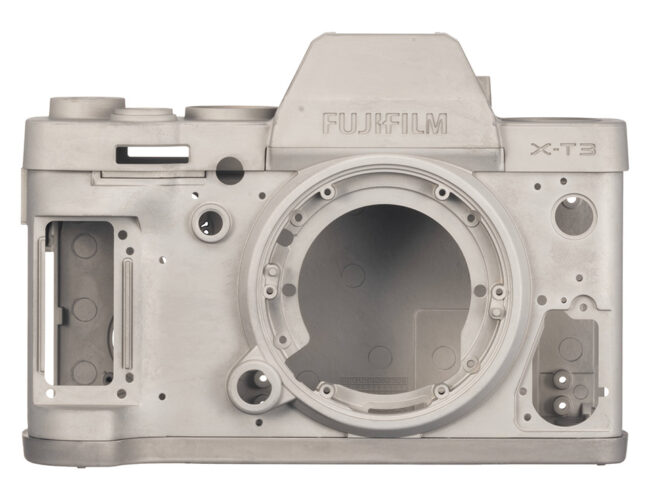
You get a good sense of the toughness of the camera when you hold it in hands – the camera feels similar to a high-end camera, with its solid construction, aluminum knobs and weather-sealed buttons. The grip is not as large and as comfortable as on the X-H1 though, so if you want a bigger grip, you might consider adding a grip accessory (you can find plenty of grip options from third-party manufacturers).
If you are not familiar with Fuji X-series cameras, they are all about retro manual dials and controls, which is why many enjoy shooting with these cameras so much. With the ISO, Shutter Speed and Exposure Compensation dials on the top of the camera, along with the Aperture control ring on lenses, the Fuji X-T3 allows for easy manual control of the exposure. For exposure changes and other controls, the X-T3 also comes with two separate rotary dials: one on the front and one on the back of the camera, similar to what we see on most Nikon DSLRs. The rotary dial on the back is typically for changing the shutter speed, while the one on the front is for changing lens aperture when using XC lenses that have no aperture rings.

Manual control does not mean that you cannot use the camera in Auto modes either – any of the exposure settings can be set to Auto (indicated as a red “A” on dials and rings), allowing Auto ISO, Aperture Priority, Shutter Priority, and Program modes – all without having a PASM dial that we are so used to seeing on many DSLR and mirrorless cameras.
In terms of overall ergonomics and button placement, the camera largely remained the same when compared to its predecessor, as I show further down, and the changes are very cosmetic. So if you are already familiar with the X-T2 controls, the X-T3 will feel right at home. First-time users should have no problem adapting to Fuji ergonomics, which are considered to be some of the easiest to learn and get used to.
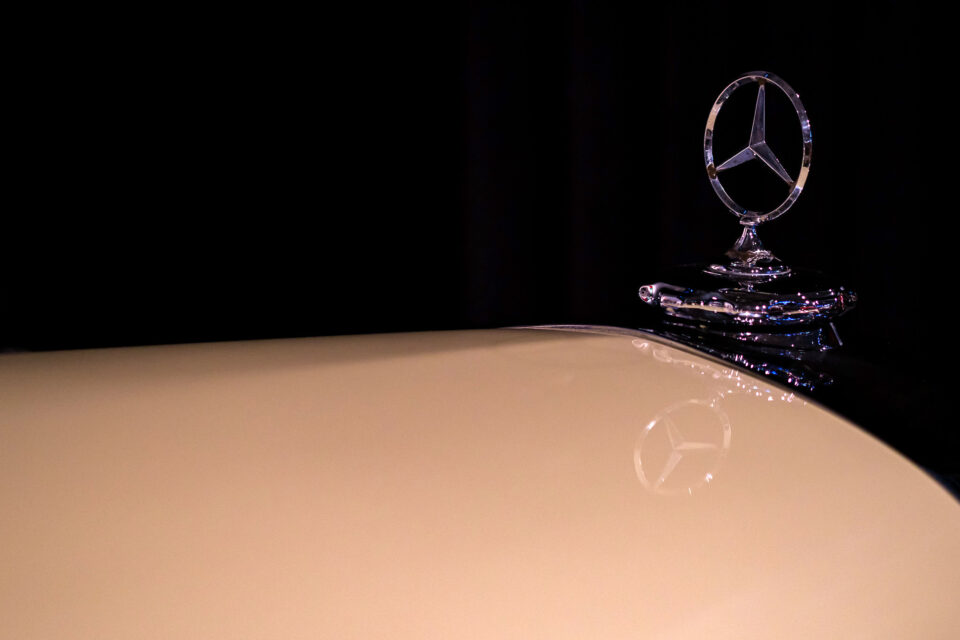
Unlike some of the latest X-series cameras, the X-T3 did not lose its D-pad, which is great news. Personally, while I am a huge fan of joysticks and their convenience for quick focus point changes, I still prefer to navigate the camera menus using the D-pad. Plus, each button on the D-pad is customizable, which really extends the functionality of the camera.
I am a big fan of the LCD screen on high-end Fuji X-series cameras, including the X-T3. The tilting screen is extremely useful for shooting high or low, since it can easily tilt in either direction, and it is also very handy when shooting in vertical orientation. All you have to do is pull the bottom middle part of the LCD screen (left side in horizontal orientation), and you can position the screen at an angle, making it easy to see what you are shooting no matter how high or low you set the camera. I love being able to tilt the screen when shooting landscapes with the camera mounted on a tripod, especially when I have to look down on the camera.

Similar to the X-T2, the X-T3 features dual SD card slots that are both compatible with both UHS-I and UHS-II memory cards. While testing out the X-T3, I used both types of memory cards from SanDisk and did not have any issues. In fact, if you are planning to use the X-T3 for shooting fast action or videos, you might seriously consider using UHS-II memory cards. For professional work and critical shoots, you might want to set up the second port as a backup. All you have to do is go to the Settings menu, navigate to “Save Data Set-Up”, select “Card Slot Settings (Still Image)” and pick “Backup” to enable simultaneous writing of images to two memory cards.

If you have large hands, you might want to consider the VG-XT3 Vertical Grip. The grip not only extends the grip of the camera, but also adds two additional batteries, which significantly increases battery life. Another benefit of the VG-XT3 battery grip is the ability to charge two batteries in the grip separately from the camera using the provided AC-9VS AC adapter. This is great, because you can set all three batteries to charge without having to swap anything out! Lastly, the battery grip is also fully weather-sealed, just like the camera, so you can use it in pretty much any weather conditions.
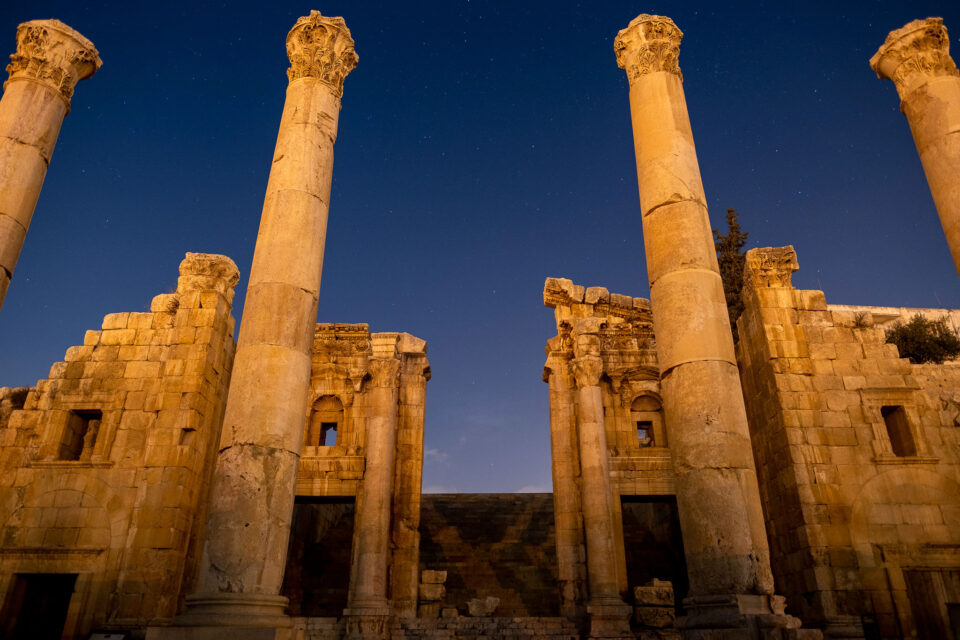
Hand-holding the camera is a breeze, especially with the VG-XT3 grip or a grip extension. Speaking of which, if all you want is to extend the size of the grip, you can purchase Fuji’s MHG-XT3 metal hand grip, which also has an Arca-Swiss compatible protrusion on the bottom.

When it comes to weather sealing, the X-T3 is sealed as well as the X-T2 is, so you should have no problems with using the camera in rainy, dusty or humid conditions.
Fuji X-T3 vs X-T2
If you are wondering what has changed from the X-T2, you will need to skip through the exterior and look at the guts of the camera, because that’s where you will find all the changes. Aesthetically and ergonomically, both cameras are nearly identical, with only minor cosmetic changes. Take a look at the top of the cameras and compare the two side-by-side (left: Fuji X-T3, right: Fuji X-T2):

As you can see, aside from the slightly smaller Exposure Compensation dial and more “edgy” switches, the rest of the layout and button placement is identical.
When looking at the backs of these cameras, we can again observe that the two are very similar. The changes are mostly near the top part of the camera, with the X-T3 having slightly angled and shorter top dials:

Basically, the appearance and the ergonomics of the camera remained largely the same. There is one distinct physical change that is worth pointing out though. While the X-T2 required a battery grip to be able to get a headphone jack for sound monitoring, the X-T3 has it on the side of the camera. This is great for those who shoot a lot of videos and want to keep the camera small and light.
Like I said earlier, if you want to see the differences between these two cameras, you will have to look at the guts of the cameras. This is where Fuji was able to bring many improvements when compared to its predecessor. Aside from the slight bump in resolution and an expanded native ISO range, the much beefier quad-core image processor brought superior autofocus capabilities, excellent 4K @ 60p 10-bit video recording features, as well as improved battery life. The continuous shooting speed has been bumped to 11 FPS without requiring a battery grip, which is great.

The video features, in particular, made the X-T3 a very attractive choice for professional videography needs. The camera is able to record video footage up to 4K at 60P in 4:2:0 10-bit format internally to an SD card (at 200 Mbps) and output 4:2:2 10-bit via HDMI (both H.264 and H.265 video formats are supported). In addition, the sensor readout speed was also been increased, resulting in reduced rolling shutter effect. Focus peaking and zebra stripes have been added when shooting 4K content, something the X-T2 was incapable of. And lastly, Fuji was able to add a new noise reduction algorithm for 4K video shooting, decreasing the minimum sensitivity for shooting F-Log footage to ISO 640. All this marked an interesting trend for Fuji to push towards a video-centric camera – a highly unusual move, considering that previous-generation Fuji cameras were known to have some of the worst video recording features on the market.
Other notable changes include a USB Type-C port for quick transfer of data and external charging, a removable input ports door, a lockable diopter, customizable touchscreen functions, improved Eye Detection AF that works in AF-C mode, new “Sports Finder Mode” to be able to shoot up to 30 FPS (electronic shutter) with a 1.25x crop factor, Color Chrome Effect, and more button customizations.

These are all important changes for those who need them, but do they justify an upgrade path from the X-T2? Unless you really need the high-end video features, I would say the answer is “no”. The X-T2 is a phenomenal camera for stills shooting and continues to be such, so if I owned the X-T2, I would skip the X-T3 and look into buying the X-T4 instead. However, if you own the original X-T1, the X-T3 is definitely worth looking into (especially with all the discounts that are offered today), because many things have changed both internally and externally since then. The addition of the joystick, dual card slots and drastic changes in autofocus performance are important enough to warrant an upgrade in my opinion.
Fuji X-T3 vs X-H1
Comparing the X-T3 to the X-H1 shows a very different picture in terms of exterior ergonomics and button layout, since the X-H1 is more of a mini-GFX-50S. While the Fuji X-T3 has a rather small grip, the X-H1 has a full-size grip similar to what one would find on a DSLR and other high-end mirrorless cameras on the market. It is not only noticeably larger but also much more comfortable to hand-hold, especially when shooting for extended periods of time. The protruded grip also allowed Fuji to move the small On / Off switch, as well as the Exposure Compensation button to the front part of the grip, which left some space for the customizable OLED top screen that displays important exposure information and other camera settings. Here is the top view of both cameras (Left: Fuji X-T3, Right: Fuji X-H1):

Personally, I am a big fan of the X-H1 layout, as it makes the camera very similar in ergonomics to my GFX 50S that I am very used to.
The back of the camera differs less when compared to the X-H1. While the number of buttons is the same, the X-H1 has larger round buttons that make them a bit more comfortable to use.The AE-L button is still to the left of the rear rotary dial, but the AF-L button on the X-H1 has been removed in favor of the AF-ON button for those who like to use back button focusing.
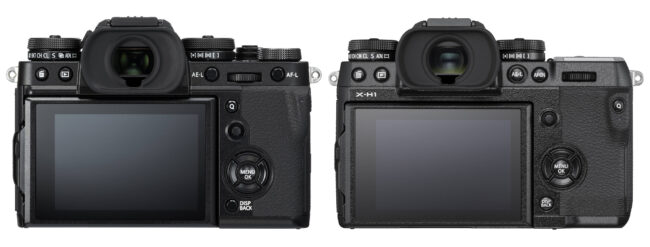
The rest of the camera buttons, ports, and switches, including those on the front, are pretty much identical to those of the X-T3. The added grip size and more robust construction do add to more total weight though. Compared to the X-T3, the X-H1 is about 135 grams heavier, making it the heaviest among the X-series cameras at 623 grams (without battery and memory card). As a comparison, the Nikon D7500 weighs a total of 640 grams without battery and memory card.
Internally, the two cameras do have different specifications, mostly in favor of the X-T3. Sadly, Fuji chose to go with the older 24.3 MP X-Trans III sensor and X-Processor III on the X-H1, while the X-T3 has the fourth-generation BSI sensor and a much faster quad-core processor. Because of these differences, the X-T3 has a 1.5x faster readout speed and 3x the performance when compared to the X-H1, which significantly reduces the rolling shutter effect, and provides noticeably better results when using the electronic shutter.

The autofocus system on the X-T3 is also superior. The X-T3 sports a 425-point hybrid AF system, while the X-H1 has the older 325-point hybrid AF system, with most of the phase-detection AF points clustered in the middle of the frame. Face and eye-detection autofocus have also been significantly improved on the X-T3, which is able to focus faster and more reliable compared to the X-H1. The continuous shooting speed of the X-T3 is also faster at 11 FPS – the X-H1 only gets to such speeds with a battery grip. The X-T3 is able to shoot blackout-free with the electronic shutter, while the X-H1 cannot do that.
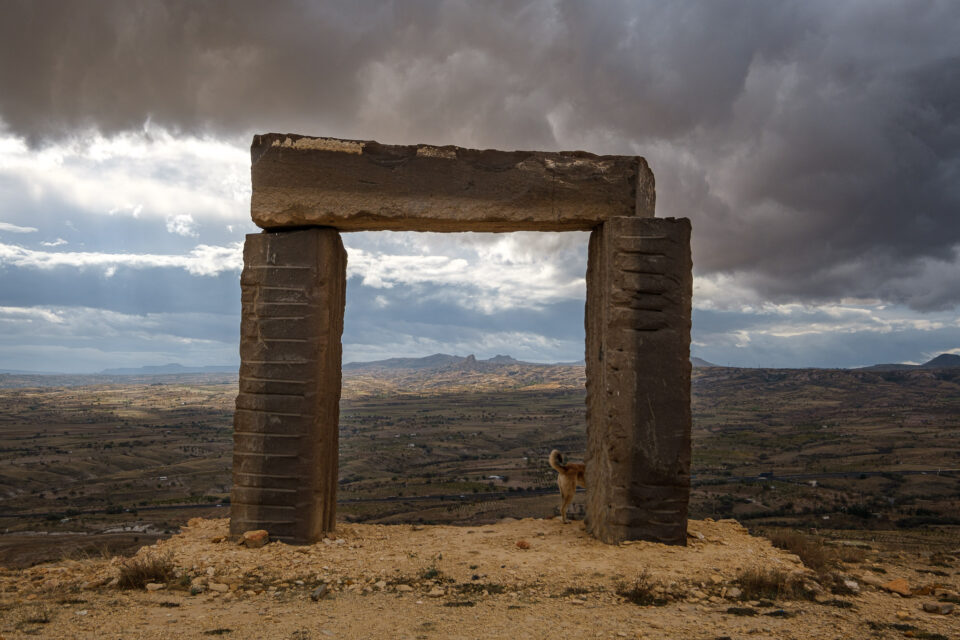
Another major difference in favor of the X-T3 has to do with video specifications. While the X-H1 is limited to 4K shooting at up to 30 FPS @ 200 Mbps max, the X-T3 doubles the frame rate to 60 FPS @ 400 Mbps. In addition, the X-T3 supports both H.264 and H.265 codecs and can shoot 10-bit video both internally (4:2:0) and externally (4:2:2). In comparison, the X-H1 is limited to H.264 codec and 8-bit video and does not have some of the newer video functions such as zebra patterns.

So far, everything I mentioned internally is in favor of the X-T3. However, there is one major feature that stands out on the X-H1, and that has to with IBIS. Unfortunately, the Fuji X-T3 does not feature IBIS like the X-H1 does, which is a bummer considering how helpful IBIS can be when doing stills or video. Personally, I am a big fan of Fuji’s IBIS on the X-H1 and I find it to be one of the best on the market. IBIS is one of the main reasons that pushed me to buy the X-H1 instead of the X-T3. And to be honest, I do not regret this decision, as all the extra AF and video features from the X-T3 are not that critical to me.

Sadly, it appears that Fuji discontinued the X-H1 line and merged it into the X-T line now. While I am going to miss the amazing ergonomics and the button layout of the X-H1, the latest Fujifilm X-T4 addressed two major issues of the X-T series line – lack of IBIS and poor battery life. More on that when I get my hands on the X-T4 later this year…